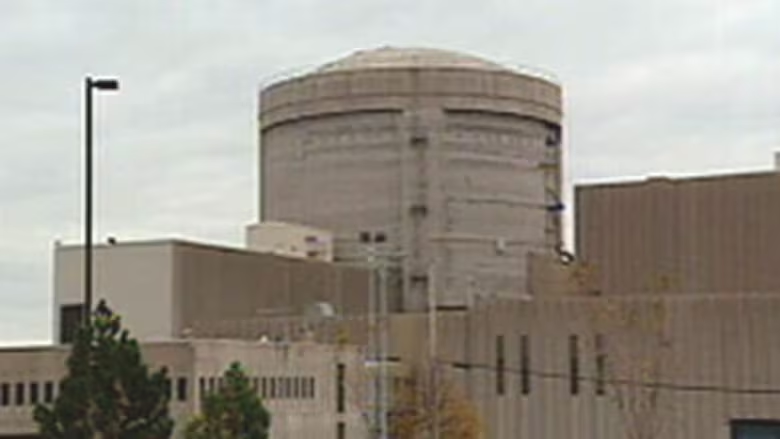Earthquake study sparks Point Lepreau safety reassessment
Chris Rouse, an environmentalist, says NB Power was using wrong calculations to assess hazard

A 2014 study of historical earthquakes in the area surrounding Point Lepreau Nuclear Generating Station, and a change to how NB Power calculates earthquake probabilities, has triggered a reassessment of seismic hazards at the power plant.
The two factors combined mean that Point Lepreau needs to be able to withstand earthquake-induced peak forces that are stronger than previously thought.
Following the study and recalculations, an NB Power "External Hazard Evaluation" document sent to the Canadian Nuclear Safety Commission in 2015 said "it is not possible to state with certainty that the new seismic hazard does not change the outcome/conclusions of the existing PSA [Probabilistic Safety Assessment]."
In a press release on April 29 NB Power said: "… additional work is on-going to further review seismic hazards and to assess potential consequences to the station."
NB Power is in the process of reperforming seismic hazard safety assessments at Point Lepreau.
It says it expects the assessments to be completed in the summer of 2016.
New quake information

The previous data that NB Power relied on when building Point Lepreau, showed the biggest known earthquake in the area to have been a 5.7 magnitude event.
A 7.0 magnitude earthquake is almost 20 times larger than a 5.7 magnitude event.
A 7.0 magnitude quake is still 100-times smaller than the 9.0 magnitude event that led to the 2011 Fukushima nuclear disaster in Japan.
The Fukushima meltdown was caused by the tsunami following the earthquake, and not the quake itself.
Revised calculations

He has spent several years researching the topic, and got involved as an intervenor during Point Lepreau's re-licensing process in 2011.
Rouse said his research revealed that the way NB Power was calculating risk probabilities was incorrect.
Lepreau is approved to withstand earthquake-induced peak forces of 0.3 g (or 30 per cent of the force of gravity).
"The biggest problem was that they were using median [data] instead of mean," said Rouse, arguing that the use of a median figure may ignore uncertainties, like very large and rare events.
"After I got involved, and kind of figured this out — that there was a difference, that they were using the wrong one — it's how we got to where we are today."
Brent Staeban, a spokesperson for NB Power, said in an email to CBC News on Monday that the utility is always trying to refine and improve its data analysis.
"We are moving in step with approved and recognized standards, codes and methodologies," said Staeben.
"The change to using mean values is consistent with this commitment to constantly updating and evolving."
A 2015 analysis of the new earthquake data, commissioned by NB Power, calculated a median figure of 0.343 g and a mean figure of 0.575 g.
Staeben said subsequent research, including 3D modelling, refined the 0.575 g figure downwards to 0.344 g.
That number is about 14.7 per cent higher than currently-approved earthquake-induced peak force of 0.3 g.
"The results of the latest hazard information, as provided in our summary, show that the mean peak ground acceleration for Point Lepreau structures is approximately 0.344 g," said Staeben.
NB Power reassessing

"Although the hazard assessment showed that the earthquake magnitudes for more frequent earthquakes that might occur over the lifetime of the station is lower than previously predicted, the magnitudes of very rare earthquakes that are unlikely to occur over the lifetime of the plant are larger than historically regarded as credible."
The press release and document do not detail the data from the 2014 earthquakes study.
The hazards update document goes on to say "interim results demonstrated that plant risk due to seismic events was acceptably low. To provide a greater level of assurance, NB Power indicated in the 2014 posting, that we will perform a full seismic PSA."
Staeben said NB Power won't speculate on what, if anything, might need to be done until the new assessment has been completed.
"If this new work identifies potential vulnerabilities at the plant to withstand seismic events that might challenge our safety objectives, NB Power will address those vulnerabilities to ensure that the safety case remains strong," said Staeben.
Friday's press release regarding the new seismic hazard assessment was not publicized by NB Power on that date, and did not appear on its news homepage.
The release is visible as an updated version of a press release dated Feb. 6, 2013.
After being contacted by CBC News on Monday May 2, Staeben said, "a summary update on NB Power website will follow."
Point Lepreau is currently offline for seven weeks of scheduled maintenance.